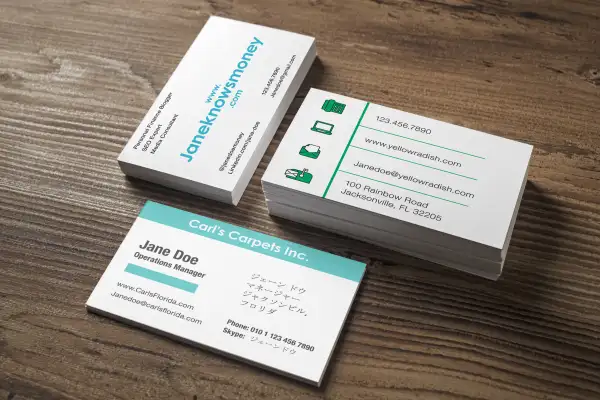How to Make a Killer Business Card

The meteoric rise of online networking has changed the way we build our career circles. But in-person introductions still rule the networking world, and business cards are still its currency.
Done right, a good business card can be a powerful branding tool that nudges the person receiving it to deepen your professional connection, through LinkedIn, networking apps, or email. It’s the connective tissue to your next career move, and it deserves the same consideration you’d put into a résumé or cover letter.
“While it’s possible to exchange information online, when you meet people in person at networking events, conferences, or by chance, you need business cards,” says Carolyn Betts, CEO of Betts Recruiting. "If you’re in a professional business, having that tangible takeaway is still a best practice."
So what makes a good business card? We ran that question by career coaches and branding specialists, and created a blueprint for the modern worker based on their advice.
Below, you'll find four expert-approved business cards, with downloadable templates, for four different types of professionals. Print a stack at home, using business card paper from an office supply store, or tap an on-demand printing service like Vistaprint or Moo (FYI: if you use a professional service, you may need to save your design as a JPEG or pdf image beforehand).
Whichever route you choose, consider spending a few extra bucks on a card case to help lug them around. A business card is your introduction to the professional world — a dirty, ripped, or otherwise damaged one doesn't make for a good first impression.
The Company Card
If you’re a business owner, or want to take advantage of your employer’s name recognition, that should be the focal point of your business card. Put the company name on the front of the card, along with a logo and tagline, if those are available to you. Use the back to list your name, title, address, phone number, and company website.
Jay Meschke, president of CBIZ Talent and Compensation Solutions, says company cards should have a clean, minimal design with an easy-to-read font and a sturdy card stock. Funky sizes are on-trend — a larger-than-average business card will stand out, the thinking goes — but he recommends sticking to the traditional size of 3.5 x 2 inches. If you’re trying to make it into someone’s wallet, pocket, or Rolodex (yes, people still buy Rolodexes) why would you give them a business card that won't fit?
“If you’re working for a business, that’s your personal calling card,” he continues. “Using a good card stock and a professionalized logo is more important.”
The same goes for content, says Megan Morahan, a creative director at the custom-printing company Vistaprint.
“It should be easily digestible for whoever is receiving it,” she says. “The less info you put on there, the better."
The Personal Brand
Some professionals are better served by an individual business card — like those who work in the gig economy, are between jobs, or want to stand on their own merit, rather than an employer’s.
If you fall into one of these categories, your name should be the most prominent feature, and the design should play to your personality.
"The key is to have the card match the message you want to send,” says Nicole Wood, CEO and founder of the career coaching company Ama La Vida. “What do you want people to pick up on? If you’re young, funky, and unique, that’s the story you’re trying to sell. But if you’re more about credibility and professionalism, that's what you need to reflect."
The content will vary depending on your profession — a freelance writer might link to Twitter, while an electrician reentering the workforce could add a Yelp review that speaks to her credibility. Make sure you link to samples of your work product via your personal website or portfolio, as well as your LinkedIn account (make sure that profile is up to date, while you’re at it).
Lisa Rangel of Chameleon Resumes recommends adding a quick tagline that sums up what you have to offer (“Freelance Web Design”) or your most meaningful skills (see above). Be discerning with the information you choose to include, she advises.
“Design with the user, and not your ego, in mind,” Rangel says. “Don't stuff too much on the card trying to impress someone. Instead, use smart word placement to pique interest and motivate further contact.”
The Creative
If you’re in a creative field like design, advertising, or fashion, you can afford to be a little more experimental with your business card.
Vistaprint’s Morahan suggests making the card a cheeky nod to your profession -- a photographer might use one side of the card to show off a favorite photo; a craft beer brewer could mimic the shape of a coaster.
You can also play with the dimensions of the card, with a unique style (square, rounded corners) and bold colors. Keep in mind that, while you get more creative license than, say, a financial planner, the objective of the card--to promote your work and facilitate new professional relationships--is the same. The above example is eye-catching, but it’s not distracting.
“You don’t want to try to make it so much fun that it's actually overriding the content of the card," Ama La Vida’s Wood says. “Make it clear how to get ahold of you.”
The Globe Trotter
If you do a lot of international travel, a bilingual business card might be the way to go. This example, which has the same information printed in Japanese on one side and English on the other, is standard practice for professionals that operate in both countries. A quick Google search can point you to dozens of companies that do translations for these types of cards, if you need it.
Employees who split their time between several different countries can also use their card to list the cities in which their company does business, Wood suggests.
Either way, make sure you include all the ways people can contact you inside and outside the U.S. — your cell phone, Skype, and WhatsApp usernames are good places to start.
As with every other example on this list, don’t overcrowd your business card with too much information. Your overseas connections appreciate a little white space just as much as your American ones, so opt for an all-English version over one that tries to mesh several languages together.
“You want to have business cards that reflect what you do and who you are,” says Carolyn Betts. “If there’s too much info, no one is going to take the time to look at it.”
Like these cards? Download the templates here.
